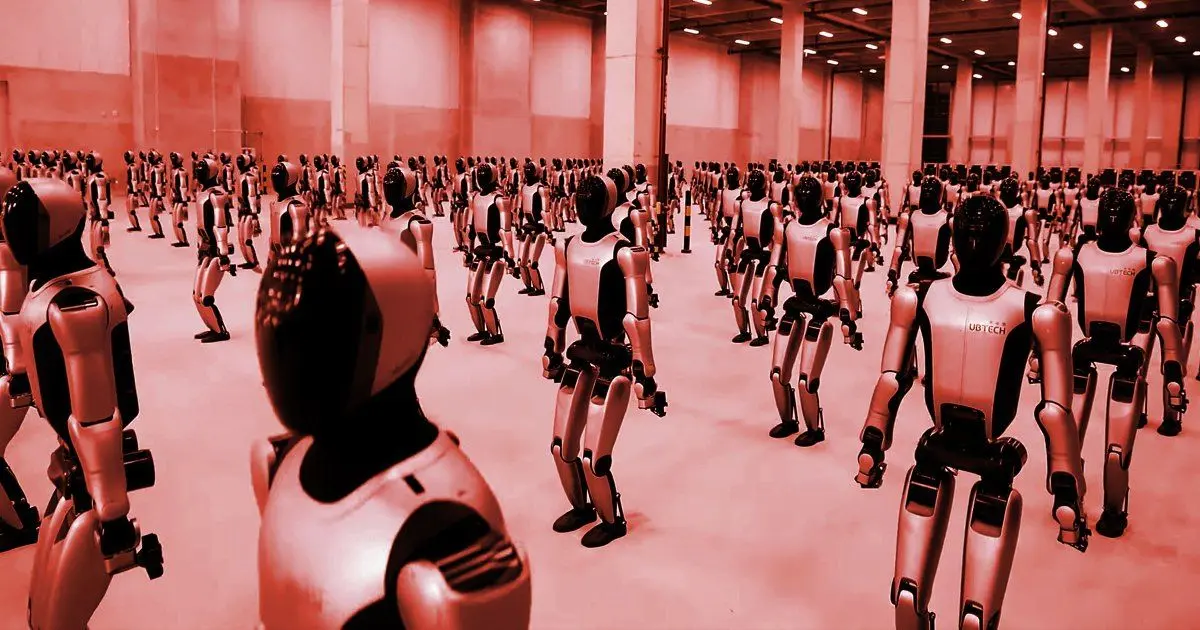China Warns of Humanoid Robot Bubble as Investment Floods Emerging Industry
3 Sources
3 Sources
[1]
A humanoid robot-shaped bubble is forming, China warns
A humanoid robot bubble could be brewing, warned China's leading economic planning agency on Thursday. The alert comes amid growing fears that a bubble in a related industry -- AI -- is about to burst. Speaking at a press briefing, National Development and Reform Commission spokesperson Li Chao said China's humanoid robotics industry needs to balance "the speed of growth against the risk of bubbles." Investment has been pouring into the sector despite there being few proven use cases for the bots, Li said, risking a flood of "highly similar" models as funding for research and development shrinks. More than 150 humanoid robotics companies are operating in China, Li said. More than half are startups or entrants from other industries. The warning marks a rare note of caution from Beijing for an industry it has declared vital for future economic growth. Earlier this year, China designated embodied intelligence -- the technology behind humanoid robotics -- a national priority.
[2]
China Is Officially Scared of Robots
Chinese officials are warning that the country's humanoid robotics industry could be forming a massive bubble. As Bloomberg reports, strategists from the National Development and Reform Commission (NDRC), which serves as the country's state-run macroeconomic management agency, say that extreme levels of investment could be drowning out other markets and research initiatives. It's a notable shift in tone as the humanoid robot industry continues to attract billions of dollars in investment. Aided by advancements in artificial intelligence opening up new use cases -- and plenty of unbridled enthusiasm -- for the tech, investors are pouring untold sums into over 150 humanoid robot companies in China alone, according to the NDRC. Many of those companies are producing robots that are extremely similar to each other, overspending that could overwhelm the market. Bike-sharing apps, for instance, flooded the market in China in 2017 and 2018, with dozens of them crowding each other out at the same time. The outcome: streets littered with unused bikes. "Frontier industries have long grappled with the challenge of balancing the speed of growth against the risk of bubbles -- an issue now confronting the humanoid robot sector as well," NDRC spokeswoman Li Chao told reporters last week, as quoted by Bloomberg. China has established itself as a clear global leader in the space, with Morgan Stanley predicting the humanoid robot market could surpass a whopping $5 trillion by 2050. Citigroup is even more optimistic, expecting the market to hit $7 trillion by that point. New offerings by companies like Unitree have made bipedal robots far more affordable and advanced than ever before. Unitree's G1 robot, in particular, has garnered tons of attention for its flashy abilities to throw punches in the ring or play basketball. A burgeoning industry of far smaller Chinese competitors has cropped up as well, fueling even more investment -- as well as concern from policymakers that the industry could be growing too fast. Last month, Chinese robotics company UBTECH claimed it had rolled out the "world's first mass delivery" of industrial humanoid robots. Startup AgiBot's A2 also set a Guinness World Record for the longest distance ever walked by a humanoid robot, with its A2 covering over 66 miles while live-swapping its battery over and over. Despite plenty of enthusiasm, turning humanoid robots into a viable and affordable product with a clear-cut use case remains a major challenge. Case in point, the current crop of androids still struggles significantly with completing household tasks, particularly without the help of a nearby human teleoperator. To speed up the process of finding real-world applications, the NDRC is hoping to spread industrial resources across the country, while also accelerating research and development for "core technologies." The risks of a bubble are certainly there. Without consolidation, China's market could soon be flooded with armies of largely identical humanoid robots -- which is either a terrifying prospect, considering the possibility of them putting us all out of work, or risks a market crash if it turns out they're not particularly good at real work.
[3]
China says humanoid robot buzz carries bubble risk
Government support and strong supply chains are helping Chinese firms push ahead in the race to develop AI-powered robots that could one day help perform everyday tasks. But the sector risks overcapacity as production scales up quickly without actual orders, Goldman Sachs warned recently. More than 150 Chinese companies are making humanoid robots but a market bubble risks forming in the rapidly growing futuristic industry, a Beijing official has warned. Government support and strong supply chains are helping Chinese firms push ahead in the race to develop AI-powered robots that could one day help perform everyday tasks. But the sector risks overcapacity as production scales up quickly without actual orders, Goldman Sachs warned recently. And on Thursday Chinese official Li Chao told a National Development and Reform Commission briefing on Thursday: "'Speed' and 'bubble' have always been issues that need grasping and balance in the development of frontier industries." She added that "the same goes for the humanoid robot industry", in answer to a question about the bubble concerns. It mirrors wider fears of a market crash fuelled by frenzied investment in artificial intelligence technology worldwide. "In recent years, driven by innovation and increased demand, humanoid robotics representing the scale of the embodied intelligence industry is seeing explosive growth," Li said Thursday. But the sector is not yet mature in terms of technology, commercialisation or use, she cautioned. More than half of China's 150 humanoid robot companies -- a figure still increasing -- are "startups or 'cross-industry' entrants, which is a good thing for innovation", Li said. "But we must also be vigilant in preventing products that are highly repetitive from 'gathering' in the market, squeezing research and development space and other risks." An April report published by Leaderobot, a specialist consulting firm, predicted that China's humanoid robotics industry would reach 82 billion yuan ($11.6 billion) in 2025, accounting for half of global sales. Large-scale real-life use cases remain elusive, but ambitious trials have grabbed headlines. A robot made by Shanghai's AgiBot set a Guinness World Record this month for the longest reported distance ever walked by a humanoid machine, having completed a three-day, 100-kilometre (62-mile) trek. Beijing also hosted the world's first-ever humanoid robot games in August, where more than 500 "athletes" vied in disciplines ranging from basketball to competitive cleaning.
Share
Share
Copy Link
China's economic planning agency warns of a potential bubble forming in the humanoid robotics sector, with over 150 companies producing similar robots amid massive investment but limited proven use cases.
Government Warning Signals Market Concerns
China's National Development and Reform Commission (NDRC) has issued a rare warning about the rapid growth of the country's humanoid robotics industry, cautioning that a market bubble could be forming amid massive investment and limited proven applications
1
. Speaking at a press briefing, NDRC spokesperson Li Chao emphasized the need to balance "the speed of growth against the risk of bubbles" in what Beijing has designated as a national priority sector1
.The warning comes as investment continues pouring into the sector despite few established use cases for humanoid robots, creating concerns about market saturation with "highly similar" models as research and development funding potentially shrinks
1
. This marks a notable shift in tone from Beijing, which earlier this year designated embodied intelligence—the technology behind humanoid robotics—as a national priority1
.
Source: ET
Market Scale and Investment Dynamics
More than 150 humanoid robotics companies are currently operating in China, with over half being startups or companies entering from other industries
1
. This explosive growth has attracted billions of dollars in investment, aided by advancements in artificial intelligence that have opened new potential use cases and generated significant investor enthusiasm2
.The market projections are staggering, with Morgan Stanley predicting the global humanoid robot market could surpass $5 trillion by 2050, while Citigroup offers an even more optimistic forecast of $7 trillion
2
. An April report by specialist consulting firm Leaderobot predicted that China's humanoid robotics industry alone would reach 82 billion yuan ($11.6 billion) in 2025, accounting for half of global sales3
.Technology Advances and Market Reality
Despite the investment enthusiasm, the sector faces significant challenges in translating technological advances into viable commercial applications. Companies like Unitree have made bipedal robots more affordable and advanced than ever before, with their G1 robot gaining attention for abilities like throwing punches and playing basketball
2
.
Source: The Verge
Recent achievements have generated headlines, including Chinese robotics company UBTECH's claim of rolling out the "world's first mass delivery" of industrial humanoid robots, and startup AgiBot's A2 robot setting a Guinness World Record by walking over 66 miles while continuously swapping batteries
2
. Another AgiBot robot completed a three-day, 100-kilometer trek, further demonstrating the technology's advancing capabilities3
.Related Stories
Challenges and Risk Factors
However, turning humanoid robots into viable, affordable products with clear use cases remains a major challenge. Current androids still struggle significantly with completing household tasks, particularly without human teleoperator assistance
2
. Goldman Sachs recently warned that the sector risks overcapacity as production scales up quickly without actual orders3
.The situation mirrors historical market bubbles in China, particularly the bike-sharing app phenomenon of 2017-2018, where dozens of companies flooded the market simultaneously, ultimately resulting in streets littered with unused bikes
2
. Officials warn that without proper market consolidation, China could face a similar scenario with "armies of largely identical humanoid robots"2
.
Source: Futurism
References
Summarized by
Navi
[2]
Related Stories
Recent Highlights
1
Google launches Gemini 3 Flash as default AI model, delivering speed with Pro-grade reasoning
Technology

2
OpenAI launches GPT Image 1.5 as AI image generator war with Google intensifies
Technology

3
OpenAI launches ChatGPT app store, opening doors for third-party developers to build AI-powered apps
Technology








